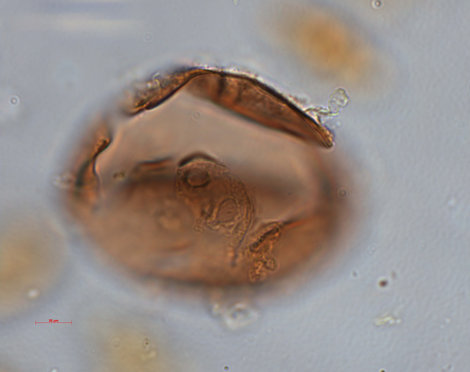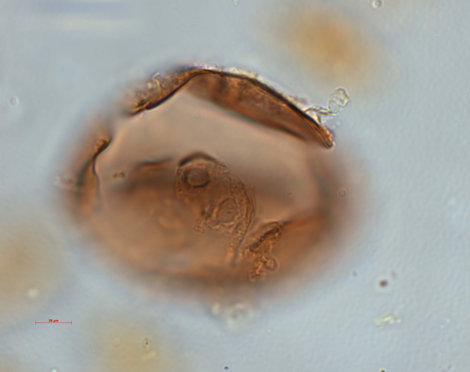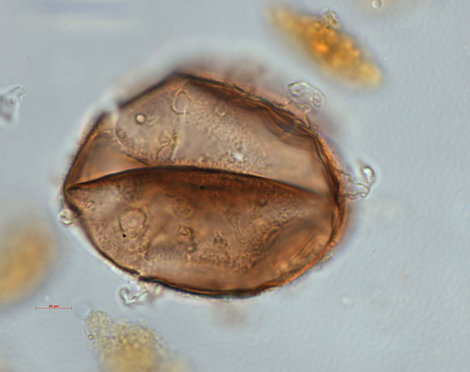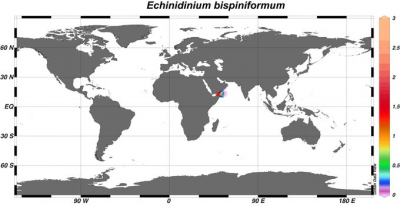Die Inhalte dieser Seite sind leider nicht auf Deutsch verfügbar.
Seitenpfad:
Echinidinium bispiniformum
Zonneveld, K.A.F. and Pospelova V. (2015). A determination key for modern dinoflagellate cysts. Palynology 39 (3), 387- 409.

dorsal view
photograph Karin Zonneveld

cross section
photograph Karin Zonneveld

ventral view
photograph Karin Zonneveld
Field characteristics
Echinidinium bispiniformum Zonneveld 1997
Characteristics:
Spheroidal cysts covered with randomly distributed spines of two different types. Cyst wall is pigmented with a smooth pedium. The first spine type is large, hollow, transparent and bulbose or bulbous in outline. It is formed by separation of the luxuria and pedium. This type of spines is flexible and can have fine solid spinules at their closed distal ends. Spine bases are subspherical to ovoidal with a diameter of about 30% of the spine length. The second spine type is small, solid, acuminate and scattered randomly between the large spines. These flexuous spines are pigmented, smooth, have (sub) sphaerical bases and are sharply pointed at their distal ends. No tabulation is reflected except for the chasmic archeopyle which consists of a split along several sutures.
Dimensions: body diameter: 39-48 μm (mean = 43.4 μm, n=14) length large spines: 4-12 μm (mean = 7.5 μm, n= 14); base large spines: 2-6 μm; length small spines: ± 2 μm, n= 14).
Motile affinity: unknown
Stratigraphic range: recent
Comparison with other species:
This species is easily recognisable on the combination of its large bulbous transparent processes and small brown processes. You can’t miss it.
Characteristics:
Spheroidal cysts covered with randomly distributed spines of two different types. Cyst wall is pigmented with a smooth pedium. The first spine type is large, hollow, transparent and bulbose or bulbous in outline. It is formed by separation of the luxuria and pedium. This type of spines is flexible and can have fine solid spinules at their closed distal ends. Spine bases are subspherical to ovoidal with a diameter of about 30% of the spine length. The second spine type is small, solid, acuminate and scattered randomly between the large spines. These flexuous spines are pigmented, smooth, have (sub) sphaerical bases and are sharply pointed at their distal ends. No tabulation is reflected except for the chasmic archeopyle which consists of a split along several sutures.
Dimensions: body diameter: 39-48 μm (mean = 43.4 μm, n=14) length large spines: 4-12 μm (mean = 7.5 μm, n= 14); base large spines: 2-6 μm; length small spines: ± 2 μm, n= 14).
Motile affinity: unknown
Stratigraphic range: recent
Comparison with other species:
This species is easily recognisable on the combination of its large bulbous transparent processes and small brown processes. You can’t miss it.
Geographic distribution
Geographic distribution based on :
Zonneveld et al., 2013. Atlas of modern dinoflagellate cyst distribution based on 2405 datapoints. Review of Palaeobotany and Palynology, v. 191, 1-197
E. bispiniformis is endemic for the Arabian Sea and characteristic for eutrophic conditions during upwelling.
Zonneveld et al., 2013. Atlas of modern dinoflagellate cyst distribution based on 2405 datapoints. Review of Palaeobotany and Palynology, v. 191, 1-197
E. bispiniformis is endemic for the Arabian Sea and characteristic for eutrophic conditions during upwelling.

Distribution:
E. bispiniformum is restricted to the tropical western Arabian Sea where it can form up to 2.7% of the association in upwelling areas.
Environmental parameter range:
SST: 23.6 - 29.0°C (summer - spring), SSS: 35.5 - 36.3 (summer - spring), [P]: 0.01 - 0.5 μmol/l, [N]: 1.6 - 3.7 μmol/l, chlorophyll-a: 0.5 - 2.6 ml/l, bottom water [O2]: 2.3 and 3.9 ml/l.
Bottom water oxygen concentrations are relatively low.
Comparison with other records:
So far B. bispiniformum has only been observed in sediments from the Arabian Sea where it is present in regions characterized by active seasonal upwelling. Cysts with cell contents have been captured in sediment traps during active upwelling (Zonneveld and Brummer, 2000).
E. bispiniformum is restricted to the tropical western Arabian Sea where it can form up to 2.7% of the association in upwelling areas.
Environmental parameter range:
SST: 23.6 - 29.0°C (summer - spring), SSS: 35.5 - 36.3 (summer - spring), [P]: 0.01 - 0.5 μmol/l, [N]: 1.6 - 3.7 μmol/l, chlorophyll-a: 0.5 - 2.6 ml/l, bottom water [O2]: 2.3 and 3.9 ml/l.
Bottom water oxygen concentrations are relatively low.
Comparison with other records:
So far B. bispiniformum has only been observed in sediments from the Arabian Sea where it is present in regions characterized by active seasonal upwelling. Cysts with cell contents have been captured in sediment traps during active upwelling (Zonneveld and Brummer, 2000).


